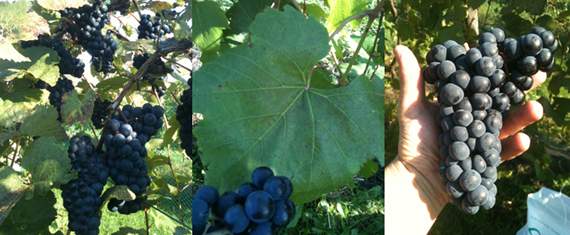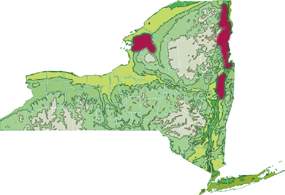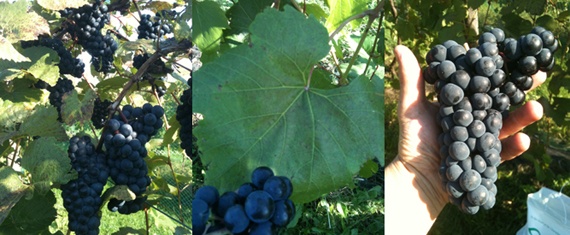
New York State, like most fine wine regions in the northern hemisphere, lies between the hallowed latitudes of 30 and 50 degrees, where macroclimates that are potentially conducive to the cultivation of wine grapes exist. Though local topological and meteorological factors have traditionally limited the places where fine wine is grown in New York, those boundaries are pushed and re-written by a new revolution in the vineyard.
Most consumers of wine made in New York, are familiar with the Finger Lakes, Long Island and the Hudson River Valley areas. Those more in tune with the industry may also know about Niagara and Lake Erie. Much of the state has shown remarkable gains in quality during the last few decades due to intrepid folk who championed the planting of traditional European varieties, at the edge of possibility.
There are new, more challenging regions emerging now too. Low winter temperatures, below zero degrees Fahrenheit, often meant certain death to buds and roots alike, among Vitis Vinifera plantings, until specific and safe mesoclimates were identified. That all important winter-kill bar has now been pushed lower, through concerted breeding efforts and resultant grape varieties, to allow more northerly exposed areas, and their equally determined inhabitants, to make fine wine on the frontier, where the viticultural climate moves from cool to cold.
 In New York’s north country, a number of growers are busy putting vines in the ground — and wines in the bottle. This is, no doubt, a nascent effort. There are a handful of wineries in each of the three most active north country areas, with new vineyard acreage expanding, and additional bonded facilities scheduled to come online within the next eighteen months.
In New York’s north country, a number of growers are busy putting vines in the ground — and wines in the bottle. This is, no doubt, a nascent effort. There are a handful of wineries in each of the three most active north country areas, with new vineyard acreage expanding, and additional bonded facilities scheduled to come online within the next eighteen months.
While many people in New York City refer to ‘upstate’ as Westchester and Dutchess counties, we are talking about way upstate — where in some cases, you really can see Canada. Specifically, these regions are: the Upper Hudson River Valley, ranging north of Albany to Lake George; the western shores and lowlands of the Lake Champlain Valley; and the Thousand Islands Region, around Watertown and the St. Lawrence Seaway.
People in these areas have been, for the last several years, quietly and steadily identifying promising sites, and making use of newly developed interspecific hybrid vines, that can survive, thrive, and regularly bear quality fruit — despite exposure to winter low temperatures down to -40 F.
Recently, the USDA posted a multi-state grant of $2.5 million to the “Northern Grapes Project”. The intent is to provide vineyard, winery and sales research support, to expand local markets for cold hardy cultivars. A recent Cornell Cooperative Extension (CCE) newsletter states that the efforts of local organizations, growers, winemakers, and volunteers, have collectively put North Country New York on the radar of the major land grant institutions.
A projected short-term outcome of the Northern Grape Project is to see a doubling of wine production and sales within the next five years as the area is expected to transform from a “non-traditional” grape region into NY’s newest wine country. There is certainly no shortage of interest, as this year, the “CCE-Cold Climate Grape Email List” has grown to over 100 subscriptions.
My interest is more than casual or academic. A family trip through the Finger Lakes in 1976, caused me to wonder quite clearly why vineyards and wineries did not exist in our own neck of the woods. That trip planted a seed of curiosity that has become deeply rooted, in my own sense of place. The urge to make wine started early, but lacking the appropriate context, wine appreciation seemed the rational path, and so 25 years of pulling corks provided the backdrop for the next stage of personal evolution. When the Cornell trial vineyard project spun up six years ago, in the Champlain lake shore town where our extended family congregates, it was a very exciting prospect. Volunteering there has provided invaluable educational exposure to the vines, relationship opportunities with growers and winemakers all over the northeast, and allowed me to harvest fruit for making my own wines at home.
A couple of those varieties are already moving to the forefront:
La Crescent, the progeny of muscat, with citrus, apricot and honey notes, done in a mineral-driven dry style, reminiscent of some rieslings.
Marquette, grandchild of pinot noir, with cherry flavors, good body, acidity and light tannins that can present like a nice gamay.
Even as a neophyte vintner, with a low interventionist approach, we have been suitably impressed with the wine quality that can be achieved. Having sampled numerous styles of wines from all over the world, it can be said with fair objectivity, that early products from the northern reaches, are on par with many commercial wines. This is not merely “cellar palate” talking, as these wines have been shared with a number of professional makers, importers, and retailers, all of whom first showed pleasant surprise at the aromas and flavors, and then asked incredulously, “you said this came from where!?”
These northern endeavors face the same infrastructure and production challenges that any wine production region does, and they also have to contend with entrenched anti-hybrid consumer biases, as well as the relative obscurity of their locations. Even with the hurdles, it is clear that this movement is here to stay. With a long history of pioneer viticulture in New York, it would seem that it is just a matter of time before the new frontier is acknowledged in its own right.
It is an educational opportunity for all of us, to see the birth and development of a new wine region, so we will be periodically bringing stories and news of New York’s North Country. There are still unknowns, which will take some time to sort out, such as creation of a comprehensive survey of vineyard areas, acreage, and varieties planted. Studies need to be done to determine the pairing of vine to sites and soil types, as well as what vine maintenance regimes are most beneficial to crop size and quality.
Of the people taking these first steps, who will succeed, and who will be paving the way for those that follow their lead? In the near term, we will plan explore the geological aspects of these newly broken grounds, take a closer look at the new grape varieties involved, and meet some of the New York fine wine lovers, who are choosing to grow, where no-one has grown before.

